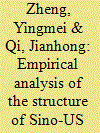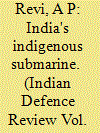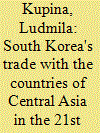| Srl | Item |
| 1 |
ID:
078278


|
|
|
|
|
| Publication |
2007.
|
| Summary/Abstract |
This paper empirically analyzes the structure of agricultural trade between China and the USA from 1996 to 2005, using different trade indexes such as the Grubel-Lloyd Index, the Revealed Comparative Advantage Index, the Finger-Kreinin Similitude Index and the Export Diversification Index, with a focus on the issues impeding Sino-US agricultural trade. We found that over the period of 1996 to 2005, inter-industry trade outweighed intra-industry trade in Sino-US agricultural trade, and that bilateral trade was more complementary than competitive. At the same time, China's agricultural exports were more diversified than USA exports, but China's degree of diversification steadily declined during the sample period. The findings indicate that there exists great potential for further development of agricultural trade between China and the USA, and that positive and effective trade policies will result in maximization of potential agricultural trade development and will bring forth mutual benefits to both countries
|
|
|
|
|
|
|
|
|
|
|
|
|
|
|
|
| 2 |
ID:
119302


|
|
|
| 3 |
ID:
127798


|
|
|
|
|
| Publication |
2014.
|
| Summary/Abstract |
This paper examines the impact of economic factors on bilateral trade flows between Malaysia and the GCC through estimations of panel data using a gravity model. In particular, the paper compares the determinants of bilateral trade and trade potentials between Malaysia and two regions, the non-traditional Gulf alliance and the traditional ASEAN counterpart, to provide insights for leveraging opportunities through trade with the former. The gravity estimates imply the importance of size effects, similarities in GDP and differences in factor endowments as drivers of trade flows between Malaysia and the GCC, underlying the fact that inter-industry trade dominates these flows. The opposite holds in the case for the Malaysia-ASEAN trade. Though export potentials for industrial products per se appear exhausted in trade with both regions, the Gulf region provides opportunities for Malaysia to export quantity-based final (end-use) products and to diversify its exporting strategy away from quality-based parts and components.
|
|
|
|
|
|
|
|
|
|
|
|
|
|
|
|
| 4 |
ID:
183434


|
|
|
|
|
| Summary/Abstract |
The author studies the structure and dynamics of trade between South Korea and Central Asia from 2000 to 2019. The existing trade turnover is unbalanced with an outdated trade structure: South Korean exports of manufactured goods predominate in mutual trade flows, while Central Asia main exports are primary commodities and raw materials. The Central Asian republics' low involvement in global value chains is the main reason for the existing inefficient trade and greatly hinders the development of investment cooperation. The implementation of reforms by Central Asian countries will contribute to the development of other trade areas and economic relations, while promoting diversification of the structure of trade with South Korea.
|
|
|
|
|
|
|
|
|
|
|
|
|
|
|
|
| 5 |
ID:
165268


|
|
|
|
|
| Summary/Abstract |
How has the Taiwan–Association of Southeast Asian Nations (ASEAN) trade evolved without having official diplomatic relations? Using several international commodity classification systems and trade pattern indices, we argue that despite political constraints, Taiwan–ASEAN trade has rapidly expanded with a significant concentration on manufacturing and intermediate goods, embodied with high-technological content. Also, by employing the Organisation of Economic Co-operation and Development’s (OECD) database on trade in value added (TiVA), we assess that Taiwan and ASEAN have become important partners in terms of trade in value addition. Nevertheless, Taiwan is seemingly lagging behind Northeast Asian economies in strengthening linkages with ASEAN over regional production networks and TiVA. This possibly results from the absence of a bilateral preferential trade agreement between Taiwan and ASEAN so far. Given the low possibility of reaching such an agreement in the near future, it is suggested that Taiwan and ASEAN should employ dynamic approaches to reap greater bilateral trade expansion and other economic benefits.
|
|
|
|
|
|
|
|
|
|
|
|
|
|
|
|